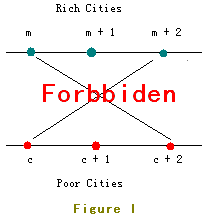HDU 1025 LIS二分优化
题目链接:
acm.hdu.edu.cn/showproblem.php?pid=1025
Constructing Roads In JGShining's Kingdom
Time Limit: 2000/1000 MS (Java/Others) Memory Limit: 65536/32768 K (Java/Others)
Total Submission(s): 28755 Accepted Submission(s): 8149
Problem Description
JGShining's kingdom consists of 2n(n is no more than 500,000) small cities which are located in two parallel lines.
Half of these cities are rich in resource (we call them rich cities) while the others are short of resource (we call them poor cities). Each poor city is short of exactly one kind of resource and also each rich city is rich in exactly one kind of resource. You may assume no two poor cities are short of one same kind of resource and no two rich cities are rich in one same kind of resource.
With the development of industry, poor cities wanna import resource from rich ones. The roads existed are so small that they're unable to ensure the heavy trucks, so new roads should be built. The poor cities strongly BS each other, so are the rich ones. Poor cities don't wanna build a road with other poor ones, and rich ones also can't abide sharing an end of road with other rich ones. Because of economic benefit, any rich city will be willing to export resource to any poor one.
Rich citis marked from 1 to n are located in Line I and poor ones marked from 1 to n are located in Line II.
The location of Rich City 1 is on the left of all other cities, Rich City 2 is on the left of all other cities excluding Rich City 1, Rich City 3 is on the right of Rich City 1 and Rich City 2 but on the left of all other cities ... And so as the poor ones.
But as you know, two crossed roads may cause a lot of traffic accident so JGShining has established a law to forbid constructing crossed roads.
For example, the roads in Figure I are forbidden.

In order to build as many roads as possible, the young and handsome king of the kingdom - JGShining needs your help, please help him. ^_^
Half of these cities are rich in resource (we call them rich cities) while the others are short of resource (we call them poor cities). Each poor city is short of exactly one kind of resource and also each rich city is rich in exactly one kind of resource. You may assume no two poor cities are short of one same kind of resource and no two rich cities are rich in one same kind of resource.
With the development of industry, poor cities wanna import resource from rich ones. The roads existed are so small that they're unable to ensure the heavy trucks, so new roads should be built. The poor cities strongly BS each other, so are the rich ones. Poor cities don't wanna build a road with other poor ones, and rich ones also can't abide sharing an end of road with other rich ones. Because of economic benefit, any rich city will be willing to export resource to any poor one.
Rich citis marked from 1 to n are located in Line I and poor ones marked from 1 to n are located in Line II.
The location of Rich City 1 is on the left of all other cities, Rich City 2 is on the left of all other cities excluding Rich City 1, Rich City 3 is on the right of Rich City 1 and Rich City 2 but on the left of all other cities ... And so as the poor ones.
But as you know, two crossed roads may cause a lot of traffic accident so JGShining has established a law to forbid constructing crossed roads.
For example, the roads in Figure I are forbidden.

In order to build as many roads as possible, the young and handsome king of the kingdom - JGShining needs your help, please help him. ^_^
Input
Each test case will begin with a line containing an integer n(1 ≤ n ≤ 500,000). Then n lines follow. Each line contains two integers p and r which represents that Poor City p needs to import resources from Rich City r. Process to the end of file.
Output
For each test case, output the result in the form of sample.
You should tell JGShining what's the maximal number of road(s) can be built.
You should tell JGShining what's the maximal number of road(s) can be built.
Sample Input
2
1 2
2 1
3
1 2
2 3
3 1
Sample Output
Case 1:
My king, at most 1 road can be built.
Case 2:
My king, at most 2 roads can be built.
Hint
Huge input, scanf is recommended.
题目大意就是给出两两配对的poor city和rich city,求解最多能修几条不相交的路。此题可以转化为LIS问题。转化过程如下:
数据中有2列,为方便表述,暂且叫做第一列和第二列。
1.若第一列是是递增的(给出的2个样例都是递增的),那么要想尽可能多的做连线,则那么就需要找出第二列中最长的递增子序列,若出现非递增的序列,那么连线后一定会相交。
2.若第一列不是递增的,排序后按照1分析即可。
综上所述,题目便转换成LIS问题。
LIS有2种写法,一种是o(n²)的写法,一种是o(nlogn)的写法。题目中给出n<=500,500.采用o(n²)必定超时,最佳策略是o(nlogn)。
推荐一篇介绍这种写法的博文
最长上升子序列nlogn算法。通俗易懂,在此就不赘述如何设计此算法了。
LIS问题,不过要优化
#include<bits/stdc++.h> #define max_v 500005 using namespace std; int a[max_v],dp[max_v],len; int main() { int n,c=1; while(~scanf("%d",&n)) { for(int i=1; i<=n; i++) { int x,y; scanf("%d %d",&x,&y); a[x]=y; } //dp[k]代表长度为k的LIS序列的最末元素, //若有多个长度为k的上升子序列, //则记录最小的那个最末元素 //dp[]中的元素是单调递增的, //二分优化的时候利用这个性质 dp[1]=a[1]; len=1; for(int i=2; i<=n; i++) { if(a[i]>dp[len]) { dp[++len]=a[i]; } else { int j=lower_bound(dp,dp+len,a[i])-dp; dp[j]=a[i]; } } if(len==1) { printf("Case %d:\nMy king, at most %d road can be built.\n\n",c++,len); }else { printf("Case %d:\nMy king, at most %d roads can be built.\n\n",c++,len); } } return 0; }
心之所向,素履以往




【推荐】国内首个AI IDE,深度理解中文开发场景,立即下载体验Trae
【推荐】编程新体验,更懂你的AI,立即体验豆包MarsCode编程助手
【推荐】抖音旗下AI助手豆包,你的智能百科全书,全免费不限次数
【推荐】轻量又高性能的 SSH 工具 IShell:AI 加持,快人一步
· SQL Server 2025 AI相关能力初探
· Linux系列:如何用 C#调用 C方法造成内存泄露
· AI与.NET技术实操系列(二):开始使用ML.NET
· 记一次.NET内存居高不下排查解决与启示
· 探究高空视频全景AR技术的实现原理
· 阿里最新开源QwQ-32B,效果媲美deepseek-r1满血版,部署成本又又又降低了!
· SQL Server 2025 AI相关能力初探
· AI编程工具终极对决:字节Trae VS Cursor,谁才是开发者新宠?
· 开源Multi-agent AI智能体框架aevatar.ai,欢迎大家贡献代码
· Manus重磅发布:全球首款通用AI代理技术深度解析与实战指南